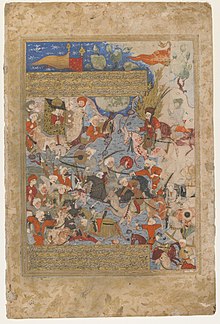
Back موقعة الجمل Arabic Cəməl döyüşü Azerbaijani جمل دؤیوشو AZB উটের যুদ্ধ Bengali/Bangla Batalla del Camell Catalan شەڕی جەمەل CKB Kamelslaget Danish Kamelschlacht German Kamel-batalo Esperanto Batalla del Camello Spanish
The Battle of the Camel (Arabic: مَعْرَكَة اَلْجَمَلِ, romanized: Maʿrakat al-Jamal) took place outside of Basra, Iraq, in 36 AH (656 CE). The battle was fought between the army of the fourth caliph Ali (r. 656–661), on one side, and the rebel army led by Aisha, Talha and Zubayr, on the other side. Ali was the cousin and son-in-law of the Islamic prophet Muhammad, while Aisha was a widow of Muhammad, of whom Talha and Zubayr were both prominent companions. Ali emerged victorious from the battle, Talha and Zubayr were both killed, and Aisha was sent back to Hejaz afterward. The triumvirate had revolted against Ali ostensibly to avenge the assassination of the third caliph Uthman (r. 644–656), although Aisha and Talha are both known to have actively opposed him. The three also called for the removal of Ali from office and for a Qurayshite council (shura) with Talha and Zubayr to appoint his successor.
- ^ Madelung 1997, p. 168.
- ^ Madelung 1997, p. 166.
- ^ MacLean 1989, p. 126.
- ^ Madelung 1997, pp. 176–7.
- ^ Madelung 1997, pp. 167–8.
- ^ Crone 2003, p. 108.
